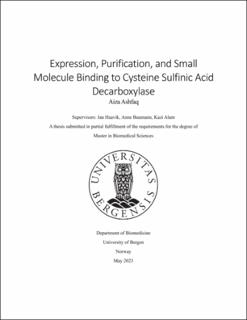Expression, Purification, and Small Molecule Binding to Cysteine Sulfinic Acid Decarboxylase
Master thesis
Permanent lenke
https://hdl.handle.net/11250/3073305Utgivelsesdato
2023-06-01Metadata
Vis full innførselSamlinger
- Master theses [28]
Sammendrag
Cysteine Sulfinic acid decarboxylase (CSAD) is a PLP-dependent enzyme involved in the biosynthesis of taurine. It converts cysteine sulfinic acid (CSA) into hypotaurine. Hypotaurine is later oxidized into taurine, one of the mammals' most common free amino acids. Numerous vital physiological functions are associated with taurine, including cell volume regulation, Ca2+ homeostasis, inflammation modulation, mitochondrial translation, and reduction of apoptosis in the central nervous system. In addition, taurine is usually considered a modulator of neurotransmission as it activates an inhibitory neurotransmitter, GABA, and inhibits an excitatory neurotransmitter, glutamate. Although taurine is critical in various physiological processes, limited research exists on taurine biosynthesis, particularly on CSAD. The discovery of inhibitors and activators of CSAD may be used to alter taurine production in the human body, resulting in increased or decreased oxidative stress, mitochondrial function, inflammation, excitotoxicity, and apoptosis. All these mechanisms can impact neurotransmission and potentially be used as a therapeutic agent against neurological disorders like Parkinson’s, Alzheimer’s, and Huntington’s disease. Therefore, this project aimed to optimize protein expression and purification of human and mouse CSAD, optimize the CSAD enzymatic activity assay, and investigate inhibitors and activators of CSAD. In this project, human and mouse CSAD was recombinantly expressed and purified. Due to low protein yield just mouse CSAD was used to screen a compound library of 344 small drug-like molecules using differential scanning fluorimetry (DSF). A total of 17 compounds with stabilizing or destabilizing effects on CSAD were further validated by a concentration-dependent assay. The hits were further tested by enzymatic activity assay. The results from the enzymatic activity of CSAD indicated that [5-Chloro-1-(cyclopropylmethyl)-6-oxo-1,6-dihydro-4-pyridazinyl](2-pyridinyl)acetonitrile (a compound from well F21 from Prestwick Original Molecules library) can be a weak inhibitor of CSAD activity, whereas, (3-Chloro-6-[3-(4-morpholinyl)propyl]amino-4-pyridazinyl)(1,3-dihydro-2H-benzimidazol-2-ylidene)acetonitrile (a compound from well D18) can be an activator or stabilizer of CSAD. Furthermore, molecular docking of these compounds against the active site of CSAD indicated that these compounds may not bind to the active site but possibly to another (allosteric) site of the CSAD.
